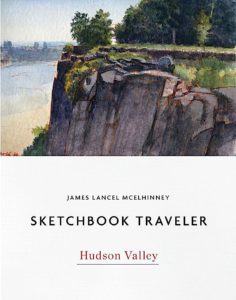Two weeks ago, I published the first in a series of daily website blog-posts. These writings and artworks that celebrate personal mobility, in pursuit of mindful engagements with history, nature and the environment. In relation to a finished painting, book, or an essay, this process is by itself as much a work of art as is the tree is to the fruit it bears. This practice might be seen as ceremonial. Beholding the world around us with care is an act of reverence. Offered as messages of hope and solidarity, these quotidian posts will continue, until the emergency is behind us.
Traveling to New Mexico early in 2019, I explored the Rio Grande between John Dunn Bridge and Cochiti Reservoir. Sites were selected for narrative reasons, as well as for their visual allure. Many of the works I produced, including my painting-journal, were exhibited at Gerald Peters Gallery in Santa Fe, in the exhibitions Reimagining New Mexico, from June 28 to August 3, and Speaking to the Imagination / The Contemporary Artist’s Book, from June 21 to October 24.

May 6, 2019. 59 degrees ESE. 36.3354 x 105.7346. Confluence of Rio Grande del Norte and Rio Pueblo de Taos.
Taos Junction Bridge is a Pratt riveted through-truss span 150 yards below the confluence of the Rio Grande del Norte and Rio Pueblo de Taos, flowing through a gorge seen to the right in this image. The confluence is undramatic, as Rio de Taos joins the great river, behind a screen of pinyon and sage. This might be considered the mouth of the Rio Grande Gorge, even though the river has another twenty-one miles to go before reaching the flood-plain at Velarde. On the left bank of the river, a dirt road winds its way past campgrounds to ascend the gorge, before connecting with blacktop roads on the plain above. From the western bridge-head, another unpaved road climbs through a series of hair-raising switchbacks, feeding onto County Road C-115, which meets US-64 just west of the Rio Grande Gorge Bridge.
Below the castle-rock towering above the confluence is a series of camp-sites, restrooms and utility sheds. Below the bridge is a parking area and boat-ramp. Carrying two kayaks, a car rolls into the dusty patch of bare soil. Within minutes, paddlers are on the river and away. Colorado snow-pack set records last winter. As snow melts, the river rises. In a week or two, or maybe tomorrow, it might be licking the girders under the bridge. Walking out onto the roadbed, a woman hold up her phone and snaps a few pictures. With the easy familiarity of an old married couple, two men walk up behind me, with their dog on a leash. One of the gents wears a porkpie hat and plaid shirt, the uniform of lumbersexual hipsters. The other taller fellow was the beau-ideal of sartorial practicality, wearing a ball-cap, light jacket and blue-jeans. Banging on about finance and investment, they disappear into the rock-fall and pinyon. Black clouds roll in from the west. The mercury drops. Packing up, I drive back toward Pilar. Passing Orilla Verde, I return to the audio-book version of Richard Powers’s The Overstory. As I turn south on highway 68, the car-radio squawks three times, followed by a flash-flood warning.
(A preview of SKETCHBOOK TRAVELER by James L. McElhinney (c) 2020. Schiffer Publishing).
Copyright James Lancel McElhinney (c) 2020 Texts and images may be reproduced (with proper citation) by permission of the author. To enquire, send a request to editions@needlewatcher.com
